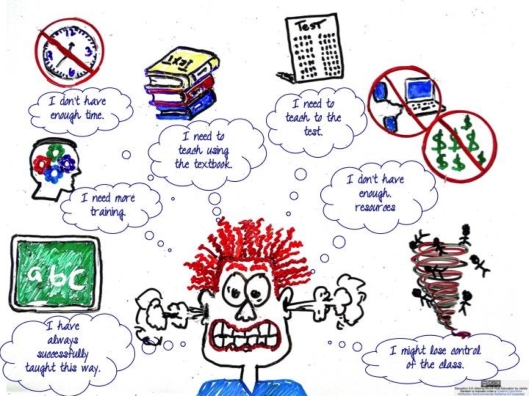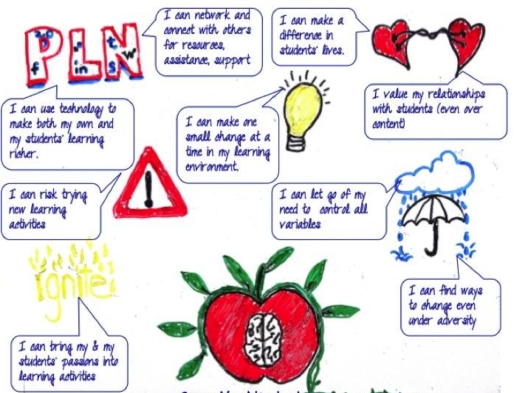Developing a Flexible & Risk-Taking Mindset
A flexible and risk-taking mindset rather than a fixed one will benefit all stakeholders in an educator’s realm: the educator’s learners, colleagues, her or his learners’ families, the community, the field of education-at-large, and of course, the educator him-or herself.
Mindset is defined as “a set of assumptions, methods, or notations held by one or more people or groups of people that is so established that it creates a powerful incentive within these people or groups to continue to adopt or accept prior behaviors, choices, or tools.” (https://en.wikipedia.org/wiki/Mindset)
Given today’s climate in education systems, one based on accountability, scripted curriculum, and teaching to the teach, far too many teachers develop a fixed mindset. Many educators feel forced into a paradigm of teaching where they feel subjected to teaching practices outside of their control. Then when they are asked to engage in a process of continued growth and development, many profess: “I don’t have enough time.”, “I don’t have enough resources.”, “I need more training.”, “I need to teach using the textbook.” ,”I need to teach to the test.”, “I might lose control of the class.”, “I have always successful taught this way.”

What happens way too often is that given these restraints, educators develop feelings of powerless and of learned helplessness. This leads to developing beliefs that they have no freedom to take risks nor to try out new things in their classrooms. Sadly, though, this becomes an over-generalization.
It is a myth that we operate under a set of oppressive bureaucratic constraints. In reality, teachers have a great deal of autonomy in the work they chose to do in their classrooms. In most cases it is our culture that provides the constraints. For individual teachers, trying out new practices and pedagogy is risky business and both our culture, and our reliance on hierarchy, provide the ideal barriers for change not to occur. As Pogo pointed out long ago, “we have met the enemy and it is us.” http://www.cea-ace.ca/blog/brian-harrison/2013/09/5/stop-asking-permission-change
Instead of this type of fixed and paralyzing mindset, educators should focus on having a flexible and risk-taking mindset. I know that these qualities can be part of a growth mindset which is usually discussed in terms of a growth vs. a fixed mindset. I wanted, though, something specific to educators that signifies their willingness to keep evolving and building their professional skills.
What follows are some strategies educators can use to develop, further develop, and maintain a flexible and risk-taking mindset:
- Develop an awareness when you enter the status quo and mediocrity complacency. Recognize it. Revisit it often. Talk about it. Shake yourself out of it in any way possible! Interestingly, Mr. C. discussed this in a very recent blog post.
I developed an “If it ain’t broke why fix it” attitude. By being comfortable and satisfied with the status quo had I stopped learning, innovating, moving forward…being successful? (Does the Status Quo Make you Comfortable?)
- Engage in continuous reflective practice. As I discussed in Where is reflection in the learning process?, educators need to be engaged in ongoing reflective practice to stay fresh and invigorated, and to insure that your actions in the learning environment are done with intentionality.
The critically reflective habit confers a deeper benefit than that of procedural utility. It grounds not only our actions, but also our sense of who we are as teachers in an examined reality. We know why we believe what we believe. A critically reflective teacher is much better placed to communicate to colleagues and students (as well as to herself) the rationale behind her practice. She works from a position of informed commitment. She knows why she does and thinks, what she does and thinks. Stephen Brookfield
- Establish both face-to-face and online personal/professional learning networks with other educators and other professionals, ones who try to live their professional lives with a flexible and risk-taking mindset.
- Try and learn new things in the classroom modeling taking risks and being a lead learner. As A.J. Juliani notes in 10 Risks Every Teacher Should Take With Their Class:
As I work with students and teachers there is one common thread that the “stand-out” classrooms share: They take risks. Not only do these students and teachers take learning risks, but they also take them together. They are partners in the learning process, where the teacher is the “lead learner”. A.J. Juliani
- Attend conferences, workshops, and other professional development opportunities outside of your comfort area . . . way outside of your comfort zone.
The bottom line becomes focusing on what can work rather than what is not working. This is not to devalue the obstacles that teachers face. It becomes about noting where change is possible and making some small changes in teaching. Small changes often result in larger, more systemic change.

. . . and sometimes having a flexible and risk-taking mindsets makes an educator an outlier educator in his or her school environment and it takes courage to be an outlier educator.

I have to say that I have always been an outlier in schools. I agree with you that teachers need to find ways to be flexible and to take risks with their own practice and learning. It comes from having a strong knowledge about how children learn and how to best accommodate their learning needs. Sometimes it can be difficult aligning that knowledge with systemic expectations, but a creative teacher can find a way. I hope I was always that creative teacher.
Norah
June 8, 2016 at 7:14 am
Good for you – and yes, creativity is the way to go!
Jackie Gerstein, Ed.D.
June 8, 2016 at 1:08 pm
School climate is a key factor in establishing a foundation of forward thinkers.
The climate must foster trust, support and encouragement. When those elements are in place, teachers are willing to share their thoughts and plans.
Yanglish
June 8, 2016 at 12:39 pm
I agree but don’t teachers help with establishing that positive school culture?
Jackie Gerstein, Ed.D.
June 9, 2016 at 1:07 am